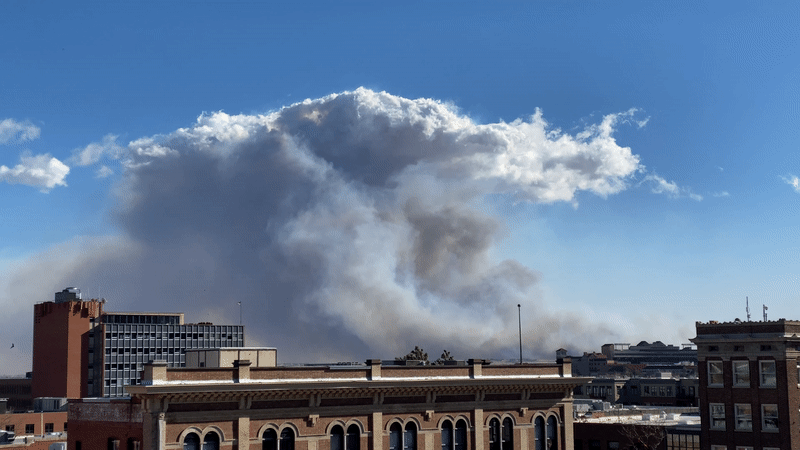Welcome to the GEOS 435, Boundary Layer Meteorology, webpage for the Spring 2022 semester.
Spring 2022 Lectures: Tues & Thurs from 12:30 - 1:45 PM in SCI 242.

Smoke from the Marshall Fire near Boulder, Colorado, on Dec. 30, 2021, is carried up into the lower-velocity part of a hydraulic jump downstream of the Rockies.
More about this event here.
More on hydraulic jumps.
This course is a ChicoFlex course with two simultaneous sections: in person and on-line.
Office hours: M & W 11:00 - 12:30 or by appointment. (in person or on-line)
(Please e-mail me in advance to schedule and wait for confirmation.)
The following is a summary of what we covered at each 75-minute class.
Tues., 25 Jan., The no-slip condition and laminar boundary layer over a smooth flat plate (Blasius BL).
Thurs., 27 Jan., The transition to turbulence over a smooth flat plate. Then, begin thermodynamics of gases.
Tues., 1 Feb., Adiabatic processes, lapse rate in a dry mixed layer, Figs. 1.1, 1.2, 1.3, and 1.5 (up to page 8) in book.
Thurs., 3 Feb., Structure and evolution of the atmospheric boundary layer over land. Figs. 1.6, 1.7, 1.8 and 1.9 in book.
Tues., 8 Feb., Homework #1 due. ABLs driven by convection and shear.
Thurs., 10 Feb., A brief look at the surface energy budget (Chapter 7, pages 251-256.)
Tues., 15 Feb., Homework #2 due. Begin Chapter 2 and statistical treatment of turbulence. Reynolds decomposition.
Thurs., 17 Feb., Rules of averaging, covariance of two variables, Begin discussion of turbulent fluxes.
Tues., 22 Feb., Reynolds decomposition, derivation of eddy covariance, kinematic versis dynamic fluxes.
Thurs., 24 Feb., Review: shear, potential temperature, stability, flux-gradient relationships, and the discontinuity at the surface.
Tues., 1 Mar., Review: dry adiabatic lapse rate, entrainment, ABL growth, calculation of covariances.
Thurs., 3 Mar., Exam #1.
Tues., 8 Mar., Derive ideal gas law and dry adiabatic lapse rate.
Thurs., 10 Mar., Review of static stability: neutral, stable, unstable environments.
Tues., 15 Mar., Spring Break.
Thurs., 17 Mar., Spring Break.
Tues., 22 Mar., Dealing with the land-atmosphere interface discontinuity: Section 7.4: Transport velocity and drag coefficient.
Thurs., 24 Mar., Momentum flux (turbulent and viscous), Friction velocity, drag/bulk transport coefficients, begin Ekman layer.
Tues., 29 Mar., Derivation of the atmospheric Ekman spiral. Section 6.4.6 on P. 210-214. Homework #4 assigned.
Thurs., 31 Mar., Cesar Chavez Day: No classes.
Tues., 5 Apr., Creating the Ekman spiral in Matlab. Begin comparing Ekman layers with real ABLs.
Thurs., 7 Apr., Finish comparing Ekman and real ABLs. Characteristics of turbulence. Distributions and moments.
Tues., 12 Apr., Begin Chapter 8: Time series analysis: Autocorrelation and structure functions and power spectra.
Thurs., 14 Apr., More discussion of Homework #4. Then discrete Fourier transforms (section 8.4)
Tues., 19 Apr., HW #4 due. Spectral energy density, Kolmogorov's inertial subrange hypothesis and Kolmogorov microscale.
Thurs., 21 Apr., Exam #2
Tues., 26 Apr., Instructor ill. Class cancelled.
Thurs., 28 Apr., The surface layer and the log wind profile under neutral conditions, roughness length.
Tues., 3 May, Displacement height, static vs dynamic stability, TKE budget, and flux and gradient Richardson numbers
Thurs., 5 May, bulk Ri, Obukhov length, similarity theory, Monin-Obukhov Similarity Theory (MOST) scaling
Tues., 10 May,
Thurs., 12 May,
May 16 - 20 Final Exam Week.
Dr. Mayor's page
